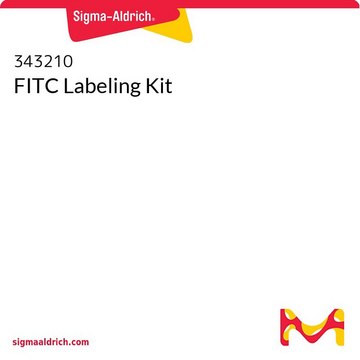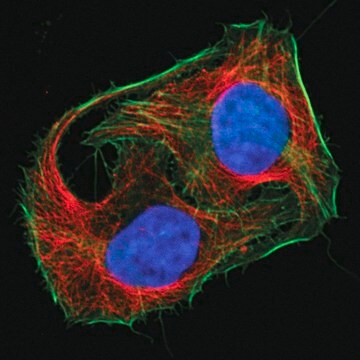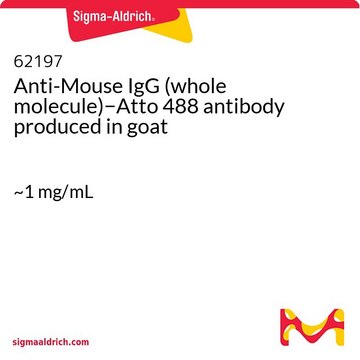Wszystkie zdjęcia(1)
Kluczowe dokumenty
38371
Atto 488 Protein Labeling Kit
BioReagent, suitable for fluorescence
Zaloguj sięWyświetlanie cen organizacyjnych i kontraktowych
About This Item
Kod UNSPSC:
12352200
NACRES:
NA.32
Polecane produkty
linia produktu
BioReagent
producent / nazwa handlowa
ATTO-TEC GmbH
fluorescencja
λex 488 nm; λem 520 nm in 0.1 M phosphate buffer, pH 7.0 (recommended)
przydatność
suitable for fluorescence
temp. przechowywania
2-8°C
Szukasz podobnych produktów? Odwiedź Przewodnik dotyczący porównywania produktów
Powiązane kategorie
Opis ogólny
This kit contains sufficient amounts of reactive dye, buffers and protein purification sets for performing five labeling reactions (1 mg protein each) and for the subsequent purification of the labeled protein.
Zastosowanie
Atto fluorescent labels are designed for high sensitivity applications, including single molecule detection. Atto labels have rigid structures that do not show any cis-trans-isomerization. Thus these labels display exceptional intensity with minimal spectral shift on conjugation. Atto 488 Protein Labeling Kit is used to produce Atto 488 labeled proteins via conjugation to primary amine groups.
Informacje prawne
This product is for Research use only. In case of intended commercialization, please contact the IP-holder (ATTO-TEC GmbH, Germany) for licensing.
Ta strona może zawierać tekst przetłumaczony maszynowo.
Kod klasy składowania
10 - Combustible liquids
Klasa zagrożenia wodnego (WGK)
WGK 3
Temperatura zapłonu (°F)
Not applicable
Temperatura zapłonu (°C)
Not applicable
Wybierz jedną z najnowszych wersji:
Masz już ten produkt?
Dokumenty związane z niedawno zakupionymi produktami zostały zamieszczone w Bibliotece dokumentów.
Klienci oglądali również te produkty
Andrea Pallares Pallares et al.
Food & function, 9(12), 6544-6554 (2018-11-28)
The presence of cell walls entrapping starch granules in common bean cotyledons, prevailing after thermal processing and mechanical disintegration, has been identified as the main reason for their (s)low in vitro starch digestibility. Nevertheless, it is unknown if the role
Switching modulation for protein labeling with activatable fluorescent probes.
Kalyan K Sadhu et al.
Chembiochem : a European journal of chemical biology, 12(9), 1299-1308 (2011-06-02)
Daniela C Dieterich
Current opinion in neurobiology, 20(5), 623-630 (2010-07-24)
Fluorescent proteins have revolutionized cell biology and, therefore, our understanding of the complex molecular and cellular mechanisms that wire the brain together and enable its plasticity throughout life. The ability to visualize cell biological processes has inspired the development of
Gražvydas Lukinavičius et al.
Current opinion in chemical biology, 15(6), 768-774 (2011-11-15)
Numerous synthetic fluorophores have been developed that can switch their spectroscopic properties upon interaction with other molecules or by irradiation with light. In recent years, protein-labeling techniques have been introduced that permit the specific attachment of such molecules to proteins
Lan-Tao Gou et al.
Cell, 180(6), 1212-1227 (2020-03-15)
The paternal genome undergoes a massive exchange of histone with protamine for compaction into sperm during spermiogenesis. Upon fertilization, this process is potently reversed, which is essential for parental genome reprogramming and subsequent activation; however, it remains poorly understood how this
Produkty
Sigma® offers protein labeling kits based on two types of fluorescent dyes, the Atto dyes and the Tracy dyes.
Nasz zespół naukowców ma doświadczenie we wszystkich obszarach badań, w tym w naukach przyrodniczych, materiałoznawstwie, syntezie chemicznej, chromatografii, analityce i wielu innych dziedzinach.
Skontaktuj się z zespołem ds. pomocy technicznej





